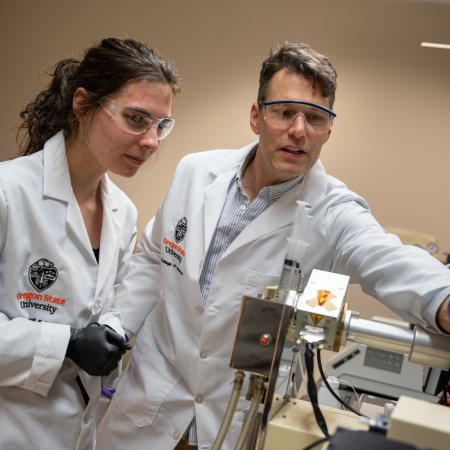CORVALLIS, Ore.— Results from the first weekend of TRACE-COVID-19 door-to-door sampling by Oregon State University suggest that about two people per 1,000 in the Corvallis community had the novel coronavirus that causes COVID-19 when they were tested.
The study, known as Team-based Rapid Assessment of Community-Level Coronavirus Epidemics, or TRACE-COVID-19 for short, began the weekend of April 25-26 and is continuing on weekends through at least May 17.
On the opening weekend, 16 two-person field teams visited 237 households spread among 30 U.S. census blocks in Corvallis. Eighty percent of people contacted by the field workers opted to participate in the study, and 455 people were tested. In the second weekend, nearly double the number of samples were collected.
Those tested during the first weekend have received their results by mail and could also opt to check their result on a secure web portal managed by TRACE. Consistent with state requirements, all test results were shared with the county health department and the Oregon Health Authority.
Results from the subsequent weekends will include information regarding demographics and symptom prevalence, TRACE organizers said.
Jeff Bethel, an associate professor in OSU’s College of Public Health and Human Sciences and part of the TRACE leadership team, said it is difficult to know how the preliminary findings compare to other U.S. cities because few prevalence studies have been done.
“This is a snapshot in time,” he said. “Multiple weeks of results will give us a deeper statistical representation of the community’s COVID-19 health and serve as a baseline to see how the prevalence of the virus changes over time.”
Ben Dalziel, an assistant professor in the Department of Integrative Biology and the project leader, said two cases per 1,000 residents is “certainly enough to be concerned about. If we reopen too quickly we risk entering another phase of exponential growth in the number of infections.
“Ultimately, these numbers aren’t good news or bad news, but rather they help us understand what the prevalence of the virus is, which is a core component of forecasting and planning public health measures in a community.”
Justin Sanders, an assistant professor in the Carlson College of Veterinary Medicine, said TRACE’s first-week prevalence estimates validate the sampling volume being done within the study. Sanders leads the diagnostic testing component of TRACE, which operates through a partnership between the Oregon Veterinary Diagnostic Laboratory, which is located at OSU, and Willamette Valley Toxicology.
“When a disease is present at these levels, you need to test a lot of people to detect it in a community,” Sanders said. “With a pathogen this transmissible, it is important to detect infections early and before they very rapidly spread within households, neighborhoods and beyond. This is particularly important in the context of plans for reopening.”
Bethel added that another benefit of TRACE is that it rapidly informs study participants who test positive to contact their health care providers.
“These are people who otherwise would not have been tested unless they had presented the disease in very serious ways,” he said.
Original plans for the TRACE project were to gather 960 samples each weekend, but that goal has changed, Dalziel said.
“TRACE is evolving, and we are adapting,” Dalziel said. “We realized that as the project evolved, it was more important from a public health analysis perspective to reach 30 neighborhoods and eight to 12 households per neighborhood per week than focus on a total number of 960 samples per week.”
Corvallis’ population is 58,641, comprising more than half of the 93,053 people who live in Benton County. The initial TRACE results were peer-reviewed by Oregon State University faculty not associated with the project, as will be the remainder of the results.
The TRACE study is a collaboration of five OSU colleges – Science, Agricultural Sciences, the Carlson College of Veterinary Medicine, Engineering and Public Health and Human Sciences – in partnership with the Benton County Health Department.
“Benton County Health Department welcomes the opportunity to partner with Oregon State University on this critical and innovative project,” said Charlie Fautin, interim Benton County Health Department co-director. “Results from this study will help us to both learn more about the spread of COVID-19 in our community, and contribute to global knowledge and understanding of this new and challenging disease.”
The study is being initially funded by OSU and a grant from the David and Lucile Packard Foundation, and has been aided by work from the OSU Foundation and the OSU Alumni Association.
TRACE is considering extending the Corvallis study over a longer period of time, but with the same number of weekends, by delaying the May 16-17 sampling to May 23-24.
“This could allow us to do another community elsewhere in Oregon on the May 16-17 weekend,” said Dalziel, adding that the final decision regarding scheduling will be made early next week.
At each home visited by TRACE field workers, members of the household are invited to participate in the study. Those who choose to take part are asked to provide information such as their name and date of birth; to fill out a simple consent form; and to answer a few confidential, health-related questions.
Participants are given a nasal-swab test kit that they administer to themselves inside their home and their minor children if they want them to take part. The field staff wait outside, and the participants leave the completed test kits outside their front door. Field staff maintain a safe distance at all times and do not enter anyone’s home. The safety of participants and TRACE field staff is a key part of the study’s research design, Bethel said.
The tests used in TRACE-COVID-19 collect material from the entrance of the nose and are more comfortable and less invasive than the tests that collect secretions from the throat and the back of the nose.
The field workers leave participants with information about the project and how they will receive their results – expected to be available in seven to 10 days – as well as health guidance from the Benton County Health Department and the Centers for Disease Control and Prevention. Participants in the study are sent their results and those of their minor children by secure e-mail with receipt by standard mail delivery as a backup. Everyone’s personal information is safeguarded.
“Public health officials do not release names of individuals who test positive for the disease because of privacy restrictions,” said Fautin. “This is because there is concern that disclosing names can discourage people who may be infected from getting tested or seeking medical help.”
For more information on the project, visit the TRACE-COVID-19 website. The site includes a list of frequently asked questions.
COVID-19, first reported to the World Health Organization on Dec. 31, 2019, has been confirmed in more than 3.6 million people worldwide and killed more than 250,000 people. In the United States, there have been more than 1.1 million reported cases – including more than 2,800 in Oregon – and more than 70,000 deaths nationwide. Benton County has had 38 confirmed cases and five deaths.




